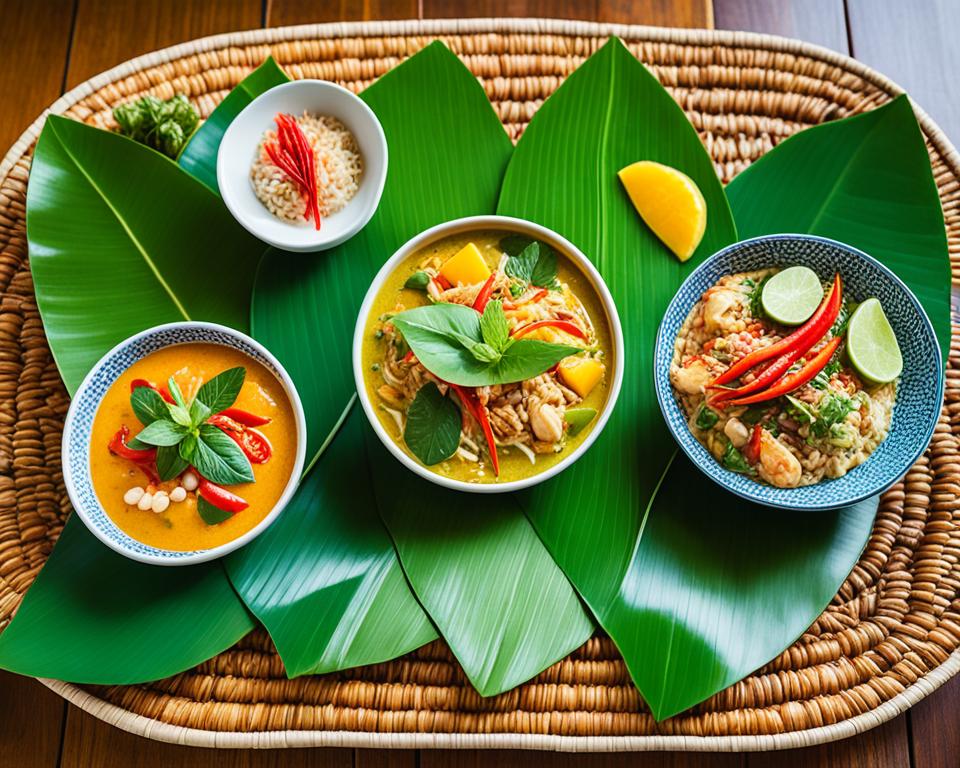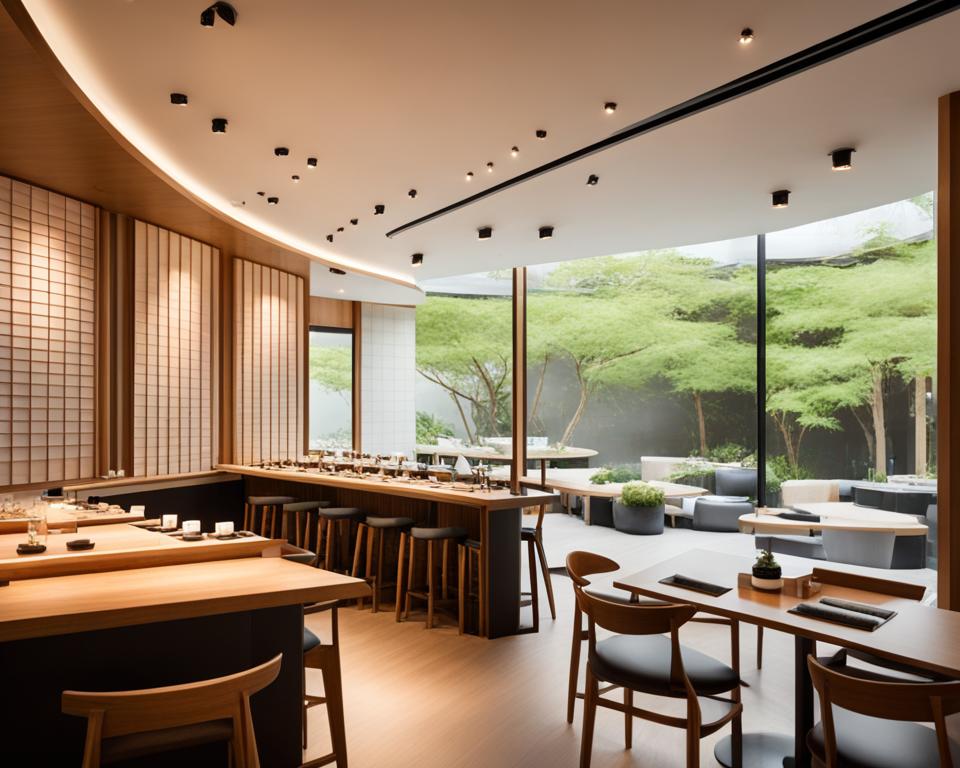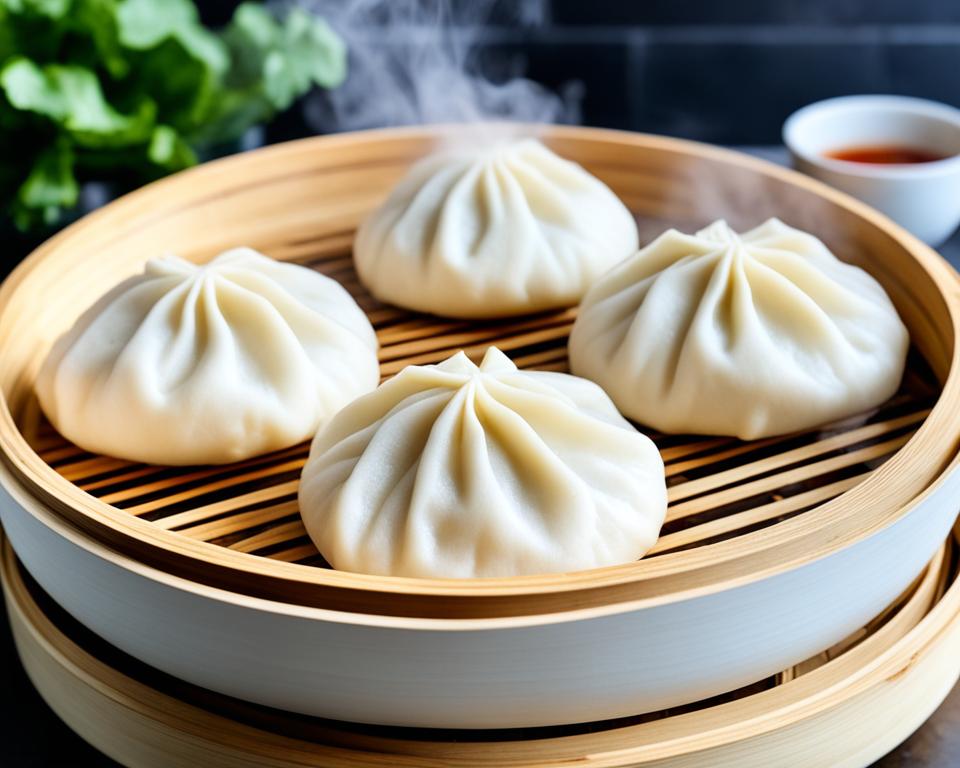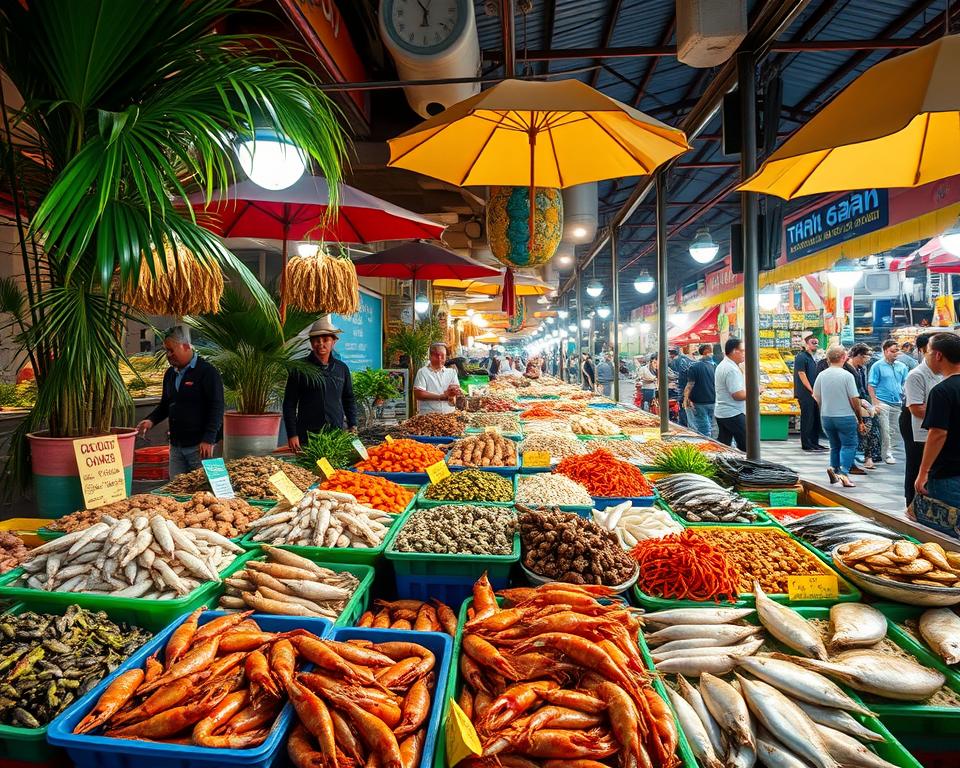Thai cuisine is a captivating culinary journey, steeped in a rich history and cultural influences that have shaped its vibrant and distinctive flavors. This comprehensive article delves into the authentic tastes and traditions of Thai food, offering readers a mouthwatering exploration of the country’s iconic dishes, essential ingredients, and cooking techniques.
From the classic Thai curries and aromatic noodle dishes to the beloved Thai street food favorites and regional specialties, this article will guide you through the diverse and complex world of Thai cuisine. Gain in-depth insights into the history, cultural influences, and essential elements that define the unique character of Thai flavors and Thai ingredients, empowering you to recreate the authentic tastes of Thailand in your own kitchen.
Whether you’re a seasoned Thai food enthusiast or a curious culinary explorer, this article promises to take you on a captivating journey through the vibrant Bangkok food scene and the rich tapestry of Thai restaurants around the world. Prepare to be inspired and delighted by the authentic and innovative offerings that make Thai cuisine a global culinary sensation.
Read more interesting information at ::kamarqgroup
Introduction to Thai Cuisine
Thai cuisine is renowned for its vibrant flavors, harmonious balance of sweet, sour, salty, and spicy elements, and the use of fresh, aromatic ingredients. The flavors of Thailand are a reflection of the country’s diverse cultural heritage, which has been shaped by centuries of trade, migration, and interaction with neighboring regions.
The Vibrant Flavors of Thailand
Thai cooking techniques and ingredients have been influenced by the culinary traditions of China, India, Malaysia, and other Southeast Asian countries, resulting in a unique and captivating fusion of tastes and textures. This diverse blend of influences has given rise to the complex and captivating flavors that characterize the Bangkok food scene and Thai cuisine as a whole.
A Blend of Influences
The Thai cuisine is a harmonious blend of sweet, sour, salty, and spicy elements, all expertly balanced to create a symphony of flavors. This unique culinary identity has been shaped by the country’s rich cultural heritage and its interactions with neighboring regions, resulting in a truly captivating and distinctive Thai cuisine.
Essential Thai Ingredients
At the heart of Thai thai ingredients cuisine lies a vibrant array of fresh herbs, aromatic spices, and flavorful seasonings that lend their distinct character to countless dishes. These essential thai flavors ingredients are the building blocks that create the signature tastes and aromas that have captivated food enthusiasts worldwide.
Fresh Herbs and Aromatics
Ingredients like lemongrass, kaffir lime leaves, galangal, cilantro, and Thai basil are indispensable in Thai cooking. These fragrant herbs and aromatics infuse Thai dishes with their unmistakable scents and impart layers of complexity to the overall flavor profile.
Spices and Seasonings
Thai cuisine also relies on a range of spices and seasonings to achieve the perfect balance of sweet, sour, salty, and spicy flavors. Fish sauce, soy sauce, shrimp paste, and chili peppers are among the essential pantry items that allow Thai cooks to craft dishes that are both bold and harmonious.
Classic Thai Curries
Thai curries are revered for their rich, complex flavors and the harmonious blending of spices, aromatics, and creamy coconut milk. Three of the most iconic thai curries are Massaman curry, green curry, and red curry, each with its own distinct character and cultural influences.
Massaman Curry
Massaman curry is a mild and aromatic curry that showcases the influence of Middle Eastern cuisine on thai dishes. This curry features a blend of warm spices, such as cinnamon, cardamom, and star anise, which create a comforting and slightly sweet flavor profile. The use of coconut milk and tender chunks of protein, often beef or chicken, lend a velvety texture to this beloved Thai dish.
Green Curry
Green curry is a vibrant and spicy curry that derives its color and heat from a blend of fresh green chilies. This curry is characterized by its lively, herbal notes, which come from the addition of ingredients like kaffir lime leaves, Thai basil, and galangal. The creaminess of coconut milk balances the fiery kick, making green curry a harmonious and deeply flavorful thai dish.
Red Curry
Red curry is a fiery and bold curry that owes its vivid color and intense heat to a blend of dried red chilies. This curry showcases the versatility of thai curries, as it can be prepared with a variety of proteins, from chicken and beef to seafood. The robust flavors of red curry, which often include lemongrass, shallots, and fish sauce, create a captivating and multidimensional dining experience.
Each of these thai curries has its own distinct character, but they all demonstrate the depth and versatility of Thai culinary traditions, blending spices, aromatics, and coconut milk into dishes that are both comforting and complex.
Noodle Dishes: A Thai Staple
Noodle dishes hold a prominent place in thai cuisine, featuring a wide variety of shapes, textures, and flavor profiles. From the ubiquitous Pad Thai to the comforting Kuay Teow Reua (boat noodles), thai dishes showcase the country’s culinary ingenuity and the versatility of this staple ingredient. These noodle-based creations often incorporate a harmonious blend of sweet, sour, and savory flavors, complemented by a variety of fresh herbs, vegetables, and proteins.
| Noodle Dish | Description |
|---|---|
| Pad Thai | A stir-fried rice noodle dish with shrimp, tamarind, and peanuts, a beloved thai cuisine classic. |
| Kuay Teow Reua | Also known as “boat noodles,” this comforting thai dish features a flavorful broth, tender meat, and rice noodles. |
| Khao Soi | A Northern thai cuisine specialty featuring egg noodles in a rich, curry-based broth with chicken or beef. |
| Pad See Ew | A stir-fried dish with wide, flat rice noodles, chinese broccoli, and a savory-sweet sauce, a popular thai dish. |
These thai dishes showcasing the versatility and creativity of thai cuisine are just a few examples of the diverse and captivating noodle dishes that have become a staple of the country’s culinary landscape.
Authentic Thai Salads
Thai salads, known as yam or tam, are vibrant, flavor-packed creations that showcase the country’s love for fresh, crunchy ingredients and bold, harmonious flavors. These salads not only provide a light and invigorating contrast to heartier Thai dishes, but also showcase the versatility and creativity of Thai cuisine.
Som Tam (Papaya Salad)
One of the most iconic Thai salads is Som Tam, a spicy and tangy green papaya salad. This dish features shredded unripe papaya tossed with a zesty dressing made from fish sauce, lime juice, chili peppers, and a touch of palm sugar. The combination of crunchy papaya, fiery chilies, and the salty-sweet-sour flavors creates a truly captivating and refreshing experience.
Yam Wun Sen (Glass Noodle Salad)
Another beloved Thai salad is Yam Wun Sen, a refreshing glass noodle salad. This dish showcases the versatility of Thai cuisine by featuring a variety of fresh vegetables, herbs, and a zesty dressing made with fish sauce, lime juice, and chili peppers. The delicate glass noodles provide a satisfying texture, while the vibrant flavors and crunchy textures create a harmonious and invigorating culinary experience.
Thai Street Food Favorites
Thai street food is a culinary treasure trove, offering a diverse array of flavorful and often portable dishes that have become beloved around the world. From the bustling markets of Bangkok to the vibrant night markets of Chiang Mai, these Thai street food favorites provide a glimpse into the country’s rich and dynamic thai cuisine culture.
Pad Thai
One of the most iconic thai dishes to emerge from the thai street food scene is Pad Thai, a stir-fried rice noodle dish that has captivated palates globally. This beloved street food staple features a harmonious blend of shrimp, tamarind, crushed peanuts, and fresh bean sprouts, all tossed together in a wok with expertly seasoned noodles.
Khao Niaow Ma Muang (Mango Sticky Rice)
Another quintessential thai street food favorite is Khao Niaow Ma Muang, a decadent dessert that showcases the country’s love for sweet, creamy flavors. This dish pairs sticky, glutinous rice with fresh, juicy mango and a rich, coconut-based sauce, creating a delightful contrast of textures and tastes that perfectly encapsulates the essence of thai cuisine.
Vegetarian Thai Recipes
Thai cuisine offers a wealth of delicious and satisfying vegetarian options that showcase the country’s love for fresh, flavorful ingredients. From tofu dishes that demonstrate the versatility of this protein-rich ingredient to vibrant vegetable stir-fries that celebrate the abundance of produce available in Thailand, the vegetarian offerings in Thai cuisine are truly remarkable.
Tofu Dishes
Tofu is a staple ingredient in many Thai vegetarian dishes, seamlessly integrating into the bold flavors and harmonious balance that define Thai cuisine. Dishes like Pad Pak Tofu (stir-fried tofu and vegetables) and Massaman Tofu Curry showcase how this versatile ingredient can be transformed into deeply satisfying and flavor-packed Thai dishes.
Vibrant Vegetable Stir-Fries
In addition to tofu-based creations, Thai cuisine also offers a wide array of vibrant vegetable stir-fries that celebrate the country’s abundant produce. Dishes like Pad Kra Pao Pak (holy basil stir-fry with mixed veggies) showcase the skilled techniques used to transform fresh, flavorful ingredients into deeply satisfying vegetarian thai recipes.
Exploring Regional Specialties
Thailand’s vast and diverse geography has given rise to distinct regional culinary traditions, each with its own unique flavors and specialties. Exploring these regional thai cuisine variations offers a deeper appreciation for the country’s rich gastronomic heritage and the way in which local influences and ingredients have shaped the development of regional thai cuisine.
Northern Thai Cuisine
Northern thai cuisine, influenced by the mountainous terrain and proximity to neighboring countries, is known for its aromatic curry pastes, hearty noodle dishes, and the use of ingredients like sticky rice and fermented sauces. The region’s proximity to Laos, Myanmar, and China has imbued its food with a distinct character, blending the flavors of the surrounding regions with traditional Thai cooking techniques.
Southern Thai Flavors
In contrast, Southern Thai cuisine reflects the region’s coastal location, with a focus on seafood, coconut-based curries, and the liberal use of spices and herbs to create bold, intense flavors. The abundance of fresh seafood and the influence of Malaysian and Indonesian culinary traditions have contributed to the unique flavor profile of Southern thai cuisine, making it a distinct and captivating facet of the country’s diverse bangkok food scene.
Cooking Methods and Techniques
Thai cooking is characterized by a variety of skillful techniques that contribute to the depth and complexity of flavors. These methods not only showcase the expertise of Thai chefs but also play a crucial role in shaping the distinctive tastes and textures of thai cuisine.
Stir-Frying
Stir-frying, known as pad in Thai, is a fundamental cooking method that allows for the quick searing and tossing of ingredients. This technique results in vibrant, well-balanced dishes where the flavors of thai cooking are expertly married together. The rapid high-heat cooking ensures that the fresh ingredients retain their natural essence and crispness, creating a harmonious symphony of textures and tastes.
Grilling and Smoking
In addition to stir-frying, thai cuisine also incorporates the use of grilling and smoking techniques to infuse dishes with a smoky, charred essence. Dishes like Moo Ping (grilled pork skewers) and Mieng Kham (betel leaf wraps) showcase the mastery of these cooking methods, which complement the other bold flavors and aromas of thai cooking.

Thai Desserts and Sweets
Thai cuisine is not only renowned for its savory dishes but also for its delectable and unique thai desserts. One of the most beloved thai cuisine desserts is Khao Niaow Ma Muang, a classic combination of sticky rice, fresh mango, and a rich, creamy coconut sauce.
Mango with Sticky Rice
Khao Niaow Ma Muang, a Thai dessert featuring sticky rice, fresh mango, and a decadent coconut sauce, is a true highlight of the thai desserts repertoire. The harmonious blend of the sweet, sticky rice, the juicy, aromatic mango, and the creamy, coconut-based sauce creates a dessert that is both indulgent and refreshing.
Coconut-Based Treats
In addition to the iconic Khao Niaow Ma Muang, Thai cooks have mastered the art of creating delicate, coconut-based treats that showcase the versatility of this beloved ingredient. Dishes like Khao Tom Mad, a steamed sticky rice with coconut and banana, and Kanom Krok, a coconut pudding served in small cups, are just a few examples of the delightful thai cuisine sweets that have captivated dessert enthusiasts around the world.
Thai Food Culture and Etiquette
Dining in Thailand is not just about the food but also the cultural traditions and etiquette that surround it. Thai cuisine is deeply rooted in the country’s rich heritage, and understanding the customs and etiquette associated with Thai meals can enhance the overall dining experience.
Thai meals are often served family-style, with multiple dishes shared among the group. It is considered polite to use the utensils provided, typically a spoon and fork, and to avoid reaching across the table. Observing these cultural customs can provide a deeper appreciation for the rich tapestry of Thai culinary traditions and the significance they hold within the Bangkok food scene.
“Dining in Thailand is not just about satisfying one’s appetite, but about embracing the social and cultural traditions that make the experience truly memorable.”
By understanding and respecting the etiquette associated with Thai cuisine, diners can immerse themselves in the country’s unique culinary culture and forge a deeper connection with the flavors, aromas, and traditions that define this captivating cuisine.
| Thai Dining Etiquette | Explanation |
|---|---|
| Family-Style Serving | Multiple dishes are shared among the group, encouraging a communal dining experience. |
| Utensil Usage | Spoons and forks are the preferred utensils, with the avoidance of reaching across the table. |
| Conversation and Behavior | Polite and respectful conversation, with minimal interruptions or loud noises. |
By embracing the cultural traditions and etiquette of Thai cuisine, diners can deepen their appreciation for the rich and captivating world of Thai culinary customs.
Exploring Thai Restaurants
Thailand’s vibrant food culture is showcased in the diverse array of thai restaurants found both within the country and around the world. From the bustling bangkok food scene to the global proliferation of Thai eateries, diners have ample opportunities to experience the full spectrum of this captivating culinary tradition.
The Bangkok Food Scene
The bangkok food scene offers a dizzying array of experiences for the discerning palate. Street food stalls, local eateries, and high-end establishments all come together to serve up authentic and innovative thai dishes, showcasing the depth and complexity of the country’s culinary heritage.
Thai Restaurants Around the World
As thai cuisine has gained global popularity, thai restaurants have proliferated across the globe, allowing diners to experience the authentic flavors of Thailand, from classic favorites to modern interpretations. Whether seeking a taste of tradition or a fusion of innovative culinary styles, these Thai eateries offer a window into the captivating world of Thai Asian food.

Fusion and Modern Thai Cuisine
While traditional Thai cuisine remains the foundation of the country’s culinary identity, the contemporary food landscape has also seen the emergence of fusion and modern Thai cooking. Chefs and culinary innovators are experimenting with new techniques, ingredients, and flavor combinations, creating exciting and unexpected dishes that still pay homage to the roots of Thai flavors. This fusion of traditional and innovative approaches has resulted in a dynamic and ever-evolving Thai food scene that continues to captivate and delight diners around the world.
From the incorporation of global ingredients to the reinterpretation of classic Thai dishes, the modern Thai cuisine movement has pushed the boundaries of what we expect from this beloved culinary tradition. Innovative chefs are blending Asian food Thai influences with techniques from Western and other international cuisines, creating unique and often visually stunning plates that still retain the essence of Thai flavors.
This fusion of tradition and innovation has breathed new life into Thai cuisine, attracting a new generation of food enthusiasts who are eager to discover the creative and unexpected directions that Thai cooking is taking. Whether it’s a contemporary twist on a beloved street food favorite or a avant-garde dish that redefines the boundaries of Asian food Thai, the modern Thai food scene is a testament to the enduring allure and adaptability of this captivating culinary tradition.
Conclusion
The captivating world of Thai cuisine has been explored in-depth, revealing the vibrant flavors, harmonious balance of tastes, and the use of fresh, aromatic ingredients that have made it a global culinary sensation. From the rich history and essential elements to the diverse regional specialties, this comprehensive guide has provided a mouthwatering journey through the authentic and innovative world of Thai Asian food.
Whether you’re an avid home cook or a food enthusiast, you now have the insights and inspiration to embark on your own delectable exploration of Thai cuisine. From classic curries and noodle dishes to beloved street food favorites and modern fusion creations, the vast array of flavors and culinary traditions waiting to be discovered in Thai Asian food is truly captivating.
As you continue to delve into the captivating world of Thai cuisine, may this guide serve as a stepping stone to a deeper appreciation and connection with the vibrant, harmonious, and ever-evolving flavors that define the essence of Thai Asian food.



